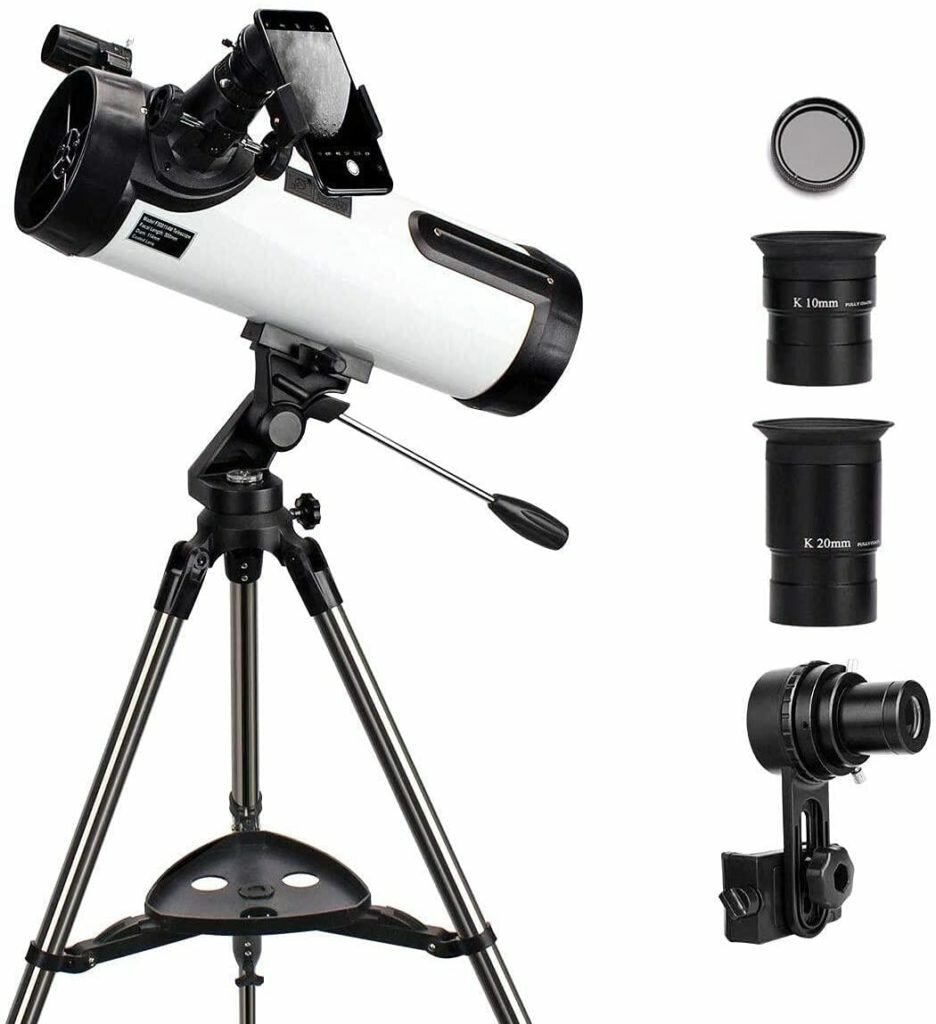When considering the best telescopes to see galaxies, there are two primary groups of objects that most people like to explore. Objects inside our Solar System (the Moon, Planets, and Comets) and extrasolar objects (Galaxies, Nebulas, Star Clusters, Constellations).
While most and top-rated telescopes are capable of capturing all of those things, others are significantly better at certain activities. For example, if your primary objective is galaxies and deep-sky objects, there are telescopes that will significantly improve your experience.
Our best telescopes to see galaxies with
Solomark 114 AZ


Solomark is a new brand that specializes in telescopes for beginner astronomers. We were pleasantly delighted by the optical quality of their products at such an affordable price.
The 114AZ is their entry-level Newtonian, and it performs in line with previous products from the manufacturer.
This is a conventional reflector telescope with a short tube that provides an adequate focal length for deep sky gazing. Additionally, it keeps the scope light and compact enough to take on a trip.
To maintain such a low price, the 114AZ makes some tiny compromises, but they are in the appropriate places, as they are items that can be upgraded later if necessary. For example, unlike some comparable telescopes, it comes with an Alt-Azimuth mount rather than an EQ mount. This simplifies its use, but the trade-off is that as you gain experience, you may find it restrictive in the future.
Best telescopes to see galaxies
Additionally, it comes with two Kellner eyepieces, a 10mm and a 20mm. These are excellent starter eyepieces, but you may eventually want to upgrade to more advanced ones, such as Plossls.
On the other hand, Solomark did not compromise on the optics. The lenses are of exceptional quality, and the photographs are vibrant and detailed. As a result, the choices they took to keep the price low were accurate.
Additionally, it includes a 1.5x Barlow lens, a moon filter, and a smartphone adapter, all of which are welcomed extras.
PROS
- Reasonable price
- Excellent performance
- Simple to operate
- High-quality optics
CONS
- Using an Alt-Azimuth mount rather than an EQ mount
Orion SkyQuest XT6


The Orion SkyQuest XT6 Dobsonian provides an appropriate blend of affordability, ease of use, and quality. Compact enough to be an excellent choice for individuals new to stargazing, yet large enough to seek a diverse array of DSOs.
Dobsonian telescopes are renowned for providing the best value in astronomy, and this one is no different. The 630 finderscope's user-friendly design and 6-inch diameter primary mirror easily reveal significant details in the brighter DSOs, such as the Orion Nebula and Andromeda Galaxy. Star clusters such as the Pleiades appear magnificent, even more so when viewed through a wide field of view eyepiece.
The telescope is simple to assemble because it is composed of two detachable components - the telescope and the base – which are connected via inbuilt springs. Even with limited experience, it takes approximately 30 minutes to assemble completely.
What else does this telescope offer?
You should be aware that this scope is quite large. It measures four feet in length (with a focal length of 1200mm / 48 inches), so you shouldn't have to move it frequently or far. On the positive side, the ultra-stable Dobsonian base secures and balances the reflector optical tube for improved viewing of remote celestial objects. At this low price point, there is no goto or tracking installed, which means you will have to manually locate and follow objects. While many of us enjoy doing so, it is not the first choice for everyone.
Sky-Watcher generously includes two 1.25′′ eyepieces with this telescope, a 25mm and a 10mm. These provide magnification of 48x and 120x, respectively, which can be enhanced by adding a 2x Barlow lens to your toolkit.
This is a simple to use telescope that is an obvious choice for DSO hunting on a budget. You may wish to upgrade to new or better eyepieces and possibly additional DSO filters to enhance your view, but most beginner astronomers will find this model difficult to fault at this price.
PROS
- 6 inch mirror suitable for brighter DSOs
- Low entry pricing
- Stable & simple setup
CONS
- Impossible to transport due to its bulkiness
- Lack of electronic tracking
- Limited supply of extras
Orion 09007 SpaceProbe 130ST - best telescopes to see galaxies


The Spaceprobe 130ST is unquestionably one of the best all-purpose reflector devices available.
The Spaceprobe 130ST has a 130mm (5.1 inch) aperture, which is the perfect compromise between a large aperture, a fair price, and a weight/size that is still deemed acceptable for travel.
Because it is a Newtonian, its focal length is limited by the tube's diameter, keeping it on the shorter side, which makes it an excellent choice for deep-sky viewing.
The included Equatorial mount is critical because, while it has a steeper learning curve for a newbie, it allows you to grow with it, so you never feel constrained by the astronomy telescope as you gain experience with astronomy.
What else does this telescope have to offer?
Two Sirius Plossl 10mm and 25mm eyepieces are provided. These are high-quality eyepieces which will last you a lifetime and may even be passed down to your next telescope if you desire to upgrade at some point.
If there is one criticism we can level at Orion, it is that they do not provide Barlow lenses or smartphone adapters by default, whereas other manufactures do. This is not a major issue because those are normally inexpensive, but you will have to purchase them separately.
While this is not a professional ultra-high-end telescope, it is an excellent entry point into astrophotography using a DSLR or even a smartphone camera.
To summarize, the Spaceprobe 130ST is so adaptable that it fits practically everybody. You cannot go wrong with it, even more so if your primary purpose is to observe galaxies.
PROS
- Affordable
- High-quality eyepieces
- It is adaptable
- It is less in weight, making it more portable
CONS
- No bundled barlow lenses or smartphone adapters
Conclusion
Searching for the best telescopes to see galaxies it can be stressful, especially if you're new to astronomy, so it's definitely usually a good idea to carefully evaluate your alternatives.
Consider your options carefully and don't settle for the first telescope that grabs your attention. Consider how you will use your telescope, where it will be utilized, and your budget. Bear in mind that the best telescope for one person may not be the greatest telescope for another.
